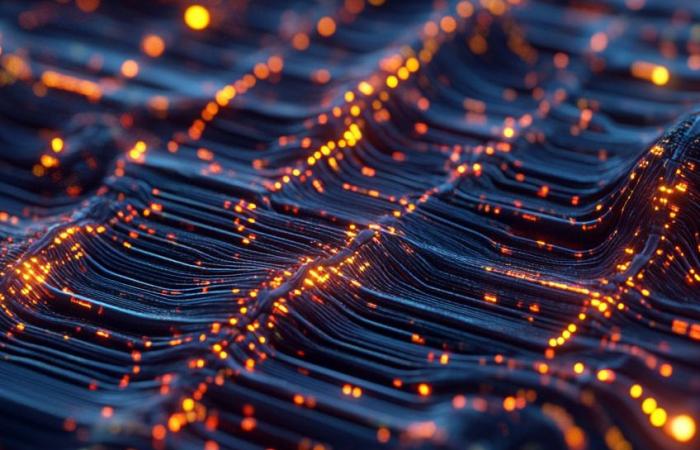Image generated by a generative AI specialized in creating images, from the following textual description: “variable activity in a silicon processor that resembles an artificial neural network ».
Human decisions made under uncertainty are often unpredictable, as is the brain activity associated with them. An Inserm team at the Cognitive and Computational Neurosciences Laboratory at the École Normale Supérieure – PSL University has just discovered the hidden benefits of this unpredictability. This work, based on simulations of neural networks used in artificial intelligence, could contribute to a better understanding of certain psychiatric illnesses whose symptoms are expressed in situations of uncertainty, such as obsessive-compulsive disorders or schizophrenia for example. The results have just been published in Science Advances.
How does our brain adapt to an unexpected situation? If he has never been confronted with it before and has no feedback to favor one choice over another, how does he manage to make a decision? To give a concrete example: what to do when your metro or bus doesn’t arrive and the information communicated orally or on notice boards is vague? Is it better to wait, try another route, walk? Having the ability to adapt and make decisions when faced with unforeseen situations is essential in our daily lives.
Valentin Wyart, Inserm research director, and his team are seeking to understand how the brain adapts to these unforeseen situations that arise on a daily basis.
“Many neuroscientists seek to identify specific brain circuits for each cognitive function, and this is the case for adaptation to uncertaintyexplains the researcher. But this approach takes into account neither the evolution of the brain nor its functioning. We therefore started with another, radically different hypothesis: our brain’s ability to adapt would be a natural consequence of its functioning. »
Brain activity is indeed known to be variable and subject to unexplained fluctuations when we have experiences, manifesting as unpredictable electrical signals. In the laboratory, this results in great variability in brain responses when the same participant is exposed to several repetitions of the same stimulation, such as an image or a sound for example.
“We imagined that our brain could rely on these fluctuations in activity to reconfigure itself in the face of new and unforeseen situations”specifies Valentin Wyart.
In other words, adaptation to uncertainty would not rely on a dedicated brain circuit, and would occur effortlessly by taking advantage of the variable activity of our brain.
To test this hypothesis, the team turned to artificial intelligence tools, in this case artificial neural networks, inspired by the neural networks in our brain, and capable of simulating cognitive processes such as memory. , learning, or decision-making. The researchers first taught these artificial neural networks to make decisions in predictable situations. Some of these networks did not exhibit variability and always activated in the same way in the same situations. Others, on the contrary, had been modified by the researchers to present variable activity, like that of the human brain. The team then exposed the two types of neural networks to new situations, including sources of uncertainty to which they had never been exposed before.
The variable networks then showed an impressive capacity to adapt almost optimally to sources of uncertainty that they had never encountered, where the networks without variability showed rigid and maladaptive behavior. Concretely, the networks played a slot machine from which they had learned some of the winning combinations. When the researchers introduced new combinations, the variable networks managed to guess which ones were winning while the networks without variability systematically failed.
How can we explain this hidden benefit of cerebral variability? Variable activity could allow the neural networks in our brain to be flexible and reconfigure themselves very quickly when new information arrives.
In addition to opening up interesting perspectives for better understanding the functioning of the human brain, these results could also have practical applications in artificial intelligence, for the development of systems capable of adapting to unforeseen situations without requiring reprogramming or specific training. Indeed, AI-based tools that we may use in the future – such as an autonomous driving system for example – must be able to adapt to situations for which they have not been specifically trained. .
Furthermore, this discovery encourages us to explore cerebral variability and measure its impact in the context of certain psychiatric illnesses which have a deleterious impact on decision-making in situations of uncertainty, such as obsessive-compulsive disorders or schizophrenia for example.
“We are currently studying cerebral variability in patients suffering from these psychiatric illnesses, but also the neurotransmitters which could be involved in the regulation of this variability”concludes Valentin Wyart.






